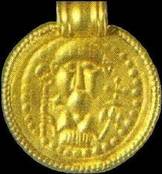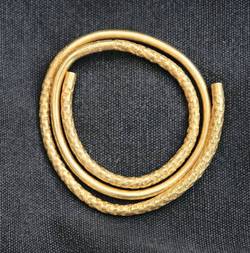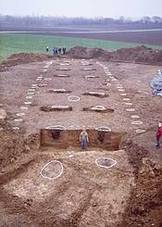Gudme

- The photograph shows the original size of the Gudme halls. After the excavations the post holes were marked with wooden stumps. The largest of the Gudme halls (on the left) measured 47 x 10 metres. The large posts which stood in two parallel rows along the length of the hall were 80 cm in diameter. This construction means that the Gudme hall was one of the largest hall buildings in Denmark in the period before the Middle Ages. Photo: Josefine Franck.
Gudme – more than just a settlement
In the Late Roman Iron Age numerous farms made up a settlement near Gudme in the south-east of Funen. In the undulating landscape near Gudme lake, around 5 km from the Great Belt coast, Gudme’s heyday began in the 3rd century AD. This is a time in which the Roman Empire’s expansion and connections to the north are clearly reflected by the many finds from the area.
The settlement reached its maximum size in the 4th and 5th centuries, when the total of farms was around 50 and the settlement area was c.1 km2.
The numerous finds from Gudme show that the area was used for settlement right up until the Middle Ages. This is unusual, as Iron Age settlements in Denmark often moved to new and more favourable locations after only one or two generations. During the excavation it was deduced that the settlement could be divided into 9 different chronological phases, each with a duration of around 50 years. After each phase the farms, fences and small buildings were taken down and rebuilt again in the same place. The farms were continually demolished and rebuilt again on the same spot from c.200 until 600 AD.
The Gudme hall – magnate’s residence and cult site
In the middle of the cluster of farms was an unusually large hall complex consisting of two parallel buildings. The largest of the buildings was an enormous hall measuring 47 x 10 metres, the roof of which was supported by eight sets of sturdy roof-bearing posts, each with a diameter of 80 cm. From the large hall building one could walk into a smaller building associated with the hall. The two hall buildings had a total internal area of c.700 m2. The larger hall building functioned for around 100 years, from the end of the 3rd century to the beginning of the 5th century AD, when the building was demolished. After this the smaller hall building continued to function until the middle of the 6th century. However, throughout this period the building was taken down and rebuilt again several times.
The function of the hall complex is unknown. However, when the main building’s exceptional size is taken into consideration, as well as the many finds of a religious nature from inside the hall and the area around it, this suggests a magnate’s residence with an associated cult building.
New excavations at Gudme
After the demolition of the unusually large Gudme hall at the beginning of the 5th century no new hall was rebuilt on the spot. Despite this the settlement continued to exist until the Middle Ages. New excavations at the location will give greater insight into the settlement’s development and continuity, together with the location’s political and religious relationships. Perhaps such excavations will even reveal the presence of an additional magnate’s residence at a yet to be investigated location in Gudme.
In September 2010 archaeologists from Svendborg Museum found a gold neckring weighing 140 g in one of the fields surrounding the Gudme settlement. The neckring lay in pottery vessel, which at one point in the past had been placed in a hole dug in the ground. It is likely to have been an offering. Photo: Museum Curator Per Thomsen.
Several of the place names near Gudme point toward the settlement at Gudme functioning as a pre-Christian cult centre. The place name Gudme means “home of the gods”. Gudbjerg means “mountain of the gods” and Galdbjerg “the sacrificial mountain”.

- This gold bracteate from Gudme depicts a female figure with a cross-like object in one hand. Frigg, Odin’s wife, is one of the great goddesses who is often depicted on continental bracteates. It is possible though that this bracteate was not produced in Denmark, but is one of the many objects imported from the Roman Empire. Therefore the cross may mark the introduction of Christianity to the Roman Empire and is thus a direct link to a new religious culture. Photo: the National Museum.




